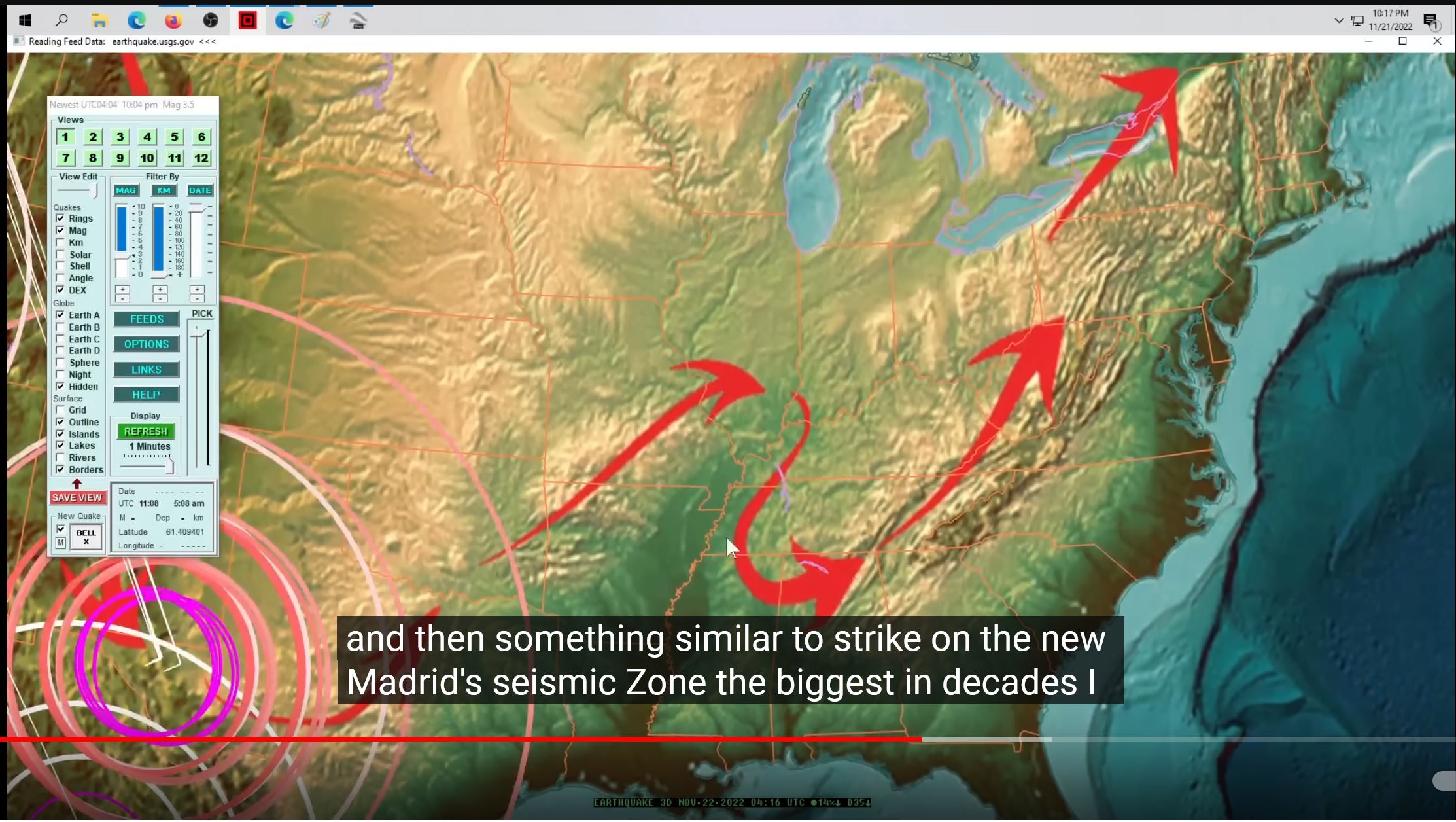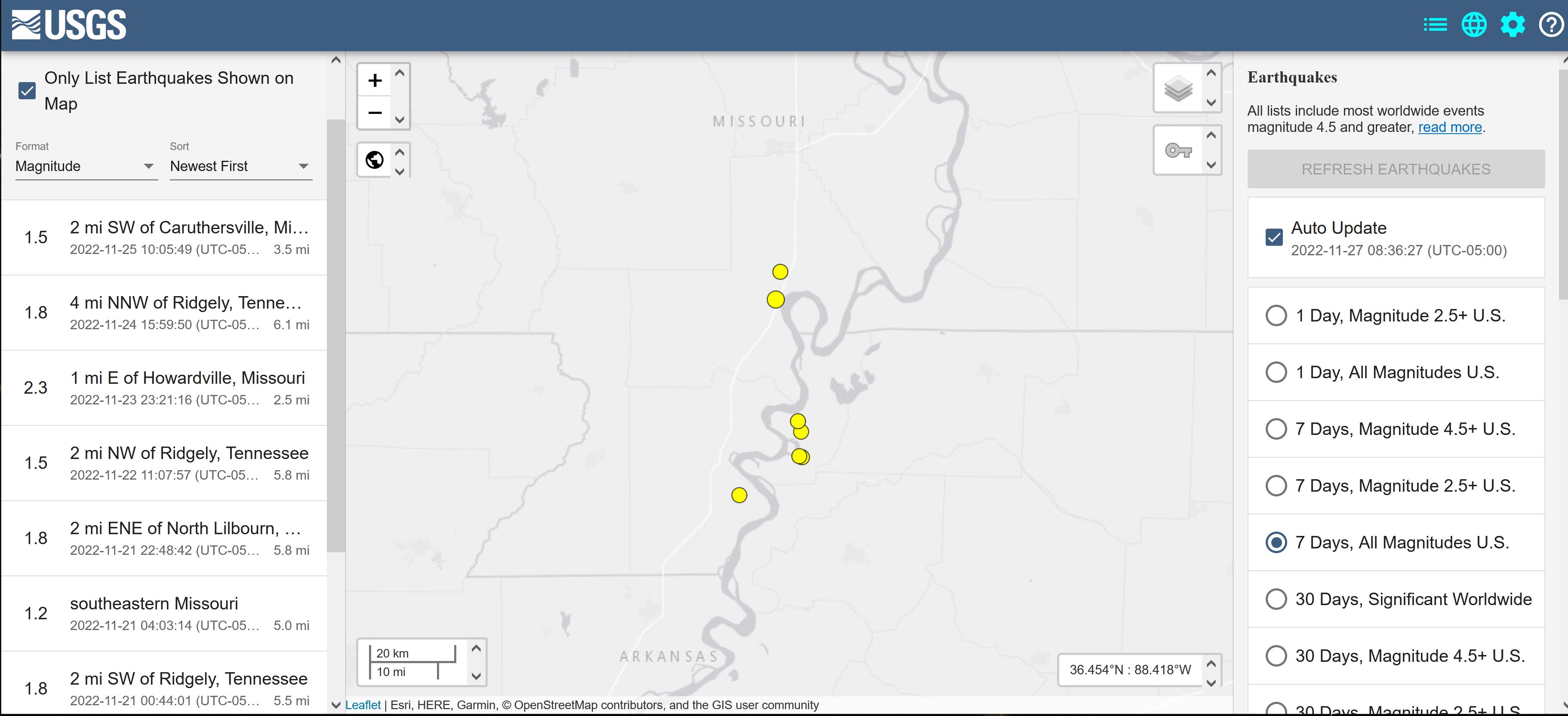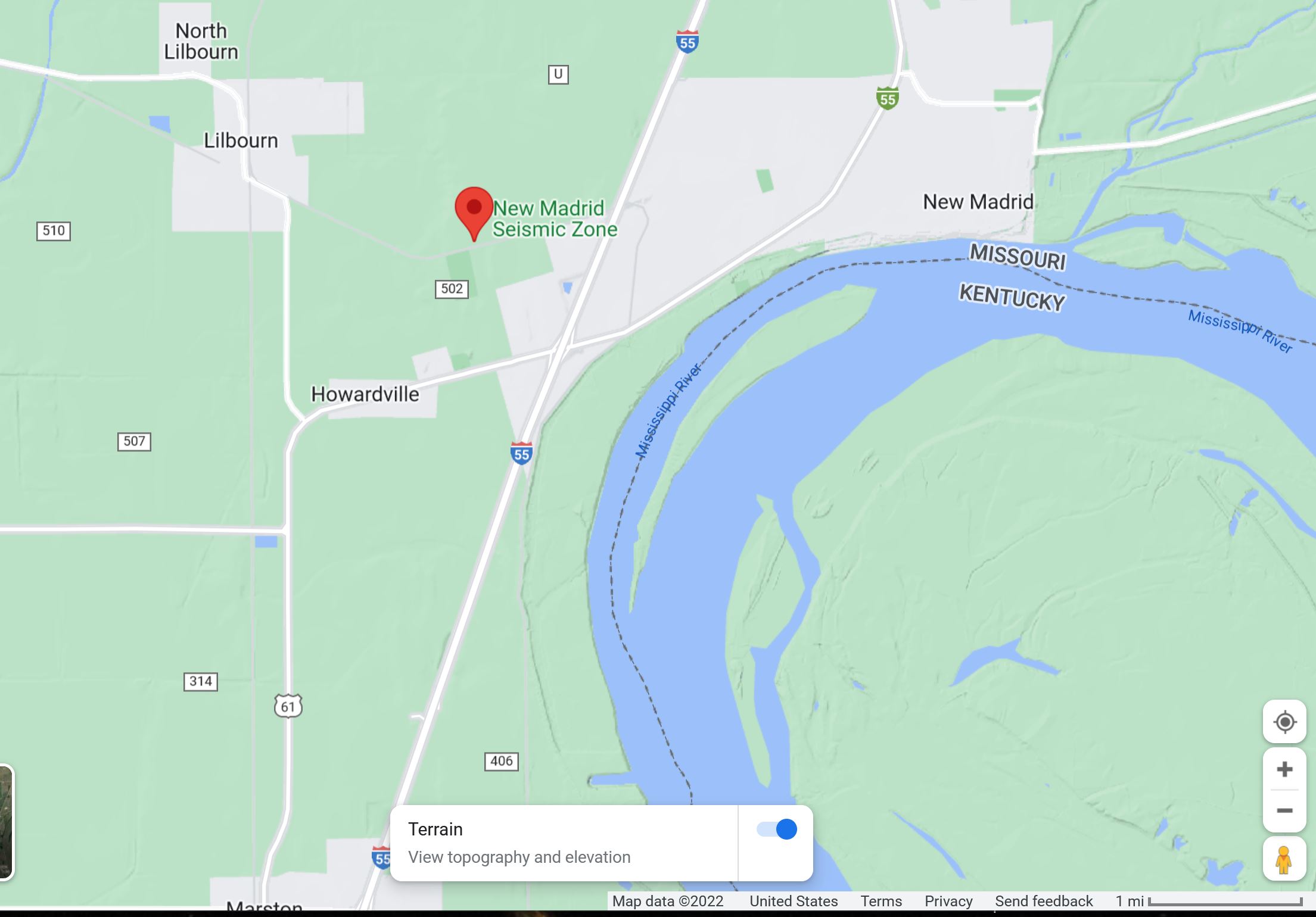It looks like you're using an Ad Blocker.
Please white-list or disable AboveTopSecret.com in your ad-blocking tool.
Thank you.
Some features of ATS will be disabled while you continue to use an ad-blocker.
11
share:
I’ve been watching this.
USA Earthquakes interest me, so I enjoy watching Dutchsinse on several formats.
His predictions follow a scientific process that anyone can repeat. The USGS is not a fan of his and Dutch often questions why they omit or misrepresent the EQ data. One of his recent studies involves the New Madrid Seismic zone. This area produced America’s worst and largest EQ. Here is his recent warning.

www.youtube.com... at 14:30.
Here is the last 7 days of reported USGS EQ activity. Notice the the USGS’s location of the most recent temblor, it’s actually in the town of New Madrid.


Hmmmm, I smell a road trip.
USA Earthquakes interest me, so I enjoy watching Dutchsinse on several formats.
His predictions follow a scientific process that anyone can repeat. The USGS is not a fan of his and Dutch often questions why they omit or misrepresent the EQ data. One of his recent studies involves the New Madrid Seismic zone. This area produced America’s worst and largest EQ. Here is his recent warning.

www.youtube.com... at 14:30.
Here is the last 7 days of reported USGS EQ activity. Notice the the USGS’s location of the most recent temblor, it’s actually in the town of New Madrid.


Hmmmm, I smell a road trip.
edit on v132022Sundayam30America/ChicagoSun, 27 Nov 2022 08:13:29 -06001 by Violater1 because: tyrdyi
originally posted by: watchitburn
a reply to: Violater1
I used to watch his videos about 10 years ago, but he does too much doom porn.
You can only do the sky is falling bit for so long before the well goes dry.
Then one day the sky actually does fall ...
originally posted by: incoserv
originally posted by: watchitburn
a reply to: Violater1
I used to watch his videos about 10 years ago, but he does too much doom porn.
You can only do the sky is falling bit for so long before the well goes dry.
Then one day the sky actually does fall ...
And that's fine, and it will fall regardless of what anyone does. But living in a perpetual state of "OMG" is not productive.
Not a fan….sorry.
Went B S C
He’s no prophet…his head got way big though.
Went B S C
He’s no prophet…his head got way big though.
I'm originally from Arkansas and most all my family live there. I suggest taking a road trip to the Nature Center at Crowleys Ridge. Here's a little
more info on the big quake back in the day.
www.arkansas.com...
www.arkansas.com...
The New Madrid Earthquake has become legendary as the worst natural disaster in North America's recorded history. Aftershocks were felt from Boston to the Rockies and from northern Canada to New Orleans.
Yet, the massive quake failed to make major headlines at the time and was almost overlooked by history, perhaps because monetary damages were low and few lives were lost during the series of shocks that lasted from December, 1811 until March, 1812.
It was tagged the "New Madrid" earthquake because the little Missouri riverport was the only settlement near the epicenter. The tremors actually began along the St. Francis River, some 65 miles southwest of New Madrid, in what is now Arkansas. In 1811, both Missouri and Arkansas were part of the Louisiana Territory. Arkansas was placed in Missouri Territory in 1812, when Louisiana became the 18th state to enter the Union.
The region devastated by the quake extended from Crowley's Ridge eastward to the present city of Memphis and northward to near Cairo, Illinois. Stories about the Mississippi River flowing backwards, forests being swallowed up, old lakes disappearing and new ones created within minutes, and the delta land rolling like gigantic ocean waves all contained some truth. However, reports passed along through casual conversation tended to exaggerate things that needed no embellishment.
Scientists now know that the 1811-12 quake was merely a continuation of a series of large tremors that have plagued the same region, every few decades, since the 1600s and long before that. However, for the first time, the New Madrid quake had a few witnesses who could report the events.
The New Orleans, first steamboat to ply the Mississippi, was descending the Ohio River when word reached its crew that strange things were occurring downstream. The boat continued its planned course, even after passengers observed large sections of the bank tear away and plunge into the river. Soon the pilot was unable to follow the main river channel due to the debris and flooding.
When the steamer reached New Madrid, the village was in shambles and some people begged to be taken aboard. Others, apparently more afraid of the bellowing steamboat than the earthquake, ran away as it approached. Primitive log cabins, with their interlocking wall construction, withstood much of the jolting action. Other types of buildings and chimneys did not fare well.
The New Orleans continued downstream, amid the aftershocks, and reached Natchez, Mississippi in early January, 1812. The only problems officially noted were the navigation hazards and changes in the channel.
People on land or in small boats were not so lucky. According to reports, the Mississippi, during the first shock at New Madrid, receded from its banks then returned as a wall of water 15 to 20 feet high. The force snapped trees and flooded lowlands instantly. Eliza Bryan, an eyewitness to this or a similar event, said the river reversed its course at New Madrid only a few minutes. Later the story grew to "several hours" and eventually "several days."
edit on 27-11-2022 by ColoradoTemplar because: (no reason given)
originally posted by: ketsuko
a reply to: incoserv
It does, but if you predict it will every day like Dutch does, then he'll eventually land a few right.
He's been right many more times than wrong. It's hard to "doooom porn" away his analysis of the New Madrid event, when even the USGS displays the last temblor, in the city of New Madrid.
Tons of activity. Little quakes around new Madrid. Mauna Loa erupted. I feel like people might need to listen to this guy. Maybe just a little bit.
Lol
new topics
-
DefCon Teetering on Escalation
World War Three: 2 hours ago -
What is your most awesome achievement or proudest moment, RE: something you were responsible for?
General Chit Chat: 5 hours ago -
Whistleblower warns FBI can’t be trusted with background checks for Trump’s nominees
Whistle Blowers and Leaked Documents: 6 hours ago -
Incoming TRUMP Admin will Declare a National Emergency to Mass Deport People Here Illegally.
Social Issues and Civil Unrest: 7 hours ago -
Like a Phoenix from the Ashes Notre-Dame Cathedral re-opens Next Month
Other Current Events: 7 hours ago
top topics
-
DefCon Teetering on Escalation
World War Three: 2 hours ago, 18 flags -
Incoming TRUMP Admin will Declare a National Emergency to Mass Deport People Here Illegally.
Social Issues and Civil Unrest: 7 hours ago, 17 flags -
Famous Catholic Exorcist Visits Mir-a-Lago
US Political Madness: 13 hours ago, 15 flags -
Whistleblower warns FBI can’t be trusted with background checks for Trump’s nominees
Whistle Blowers and Leaked Documents: 6 hours ago, 14 flags -
What is your most awesome achievement or proudest moment, RE: something you were responsible for?
General Chit Chat: 5 hours ago, 8 flags -
Like a Phoenix from the Ashes Notre-Dame Cathedral re-opens Next Month
Other Current Events: 7 hours ago, 6 flags
active topics
-
Incoming TRUMP Admin will Declare a National Emergency to Mass Deport People Here Illegally.
Social Issues and Civil Unrest • 63 • : WeMustCare -
WATCH LIVE: US Congress hearing on UFOs, unidentified anomalous phenomena
Aliens and UFOs • 127 • : putnam6 -
Where have all the good times gone????
Introductions • 25 • : lilzazz -
DefCon Teetering on Escalation
World War Three • 11 • : ADVISOR -
What is your most awesome achievement or proudest moment, RE: something you were responsible for?
General Chit Chat • 12 • : Tolkien -
-@TH3WH17ERABB17- -Q- ---TIME TO SHOW THE WORLD--- -Part- --44--
Dissecting Disinformation • 3297 • : dashen -
Whistleblower warns FBI can’t be trusted with background checks for Trump’s nominees
Whistle Blowers and Leaked Documents • 7 • : Tolkien -
The Acronym Game .. Pt.4
General Chit Chat • 972 • : JJproductions -
Post A Funny (T&C Friendly) Pic Part IV: The LOL awakens!
General Chit Chat • 7786 • : underpass61 -
Famous Catholic Exorcist Visits Mir-a-Lago
US Political Madness • 12 • : yeahright
11
